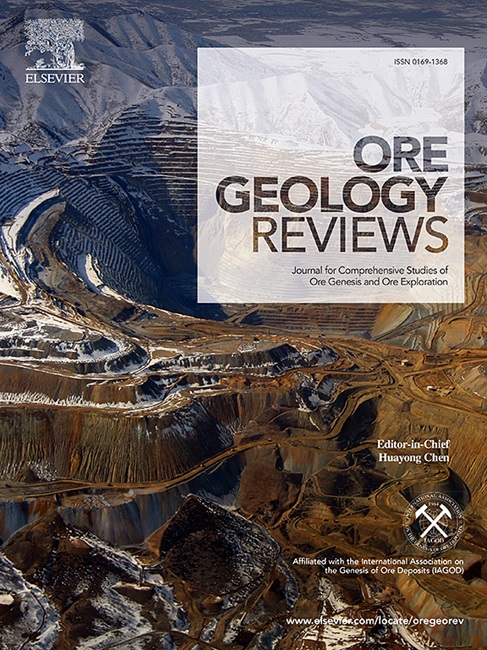Genesis of the Wangjiazhuang Cu-(Mo) deposits, Luxi Terrane, Eastern China: Implications from magnetite trace elements
IF 3.2
2区 地球科学
Q1 GEOLOGY
引用次数: 0
Abstract
The Wangjiazhuang Cu-(Mo) deposit is the largest porphyry deposit in the Zouping volcanic basin in the Luxi terrane, western Shandong Province. We investigated the petrology and reported the trace element compositions in magnetite, to further unravel the fluids evolution and ore genesis. 5 types of magnetite from 4 stages were identified: Mt1 is enriched in Mg, Al, Ti, V, Mn, Co, Ni, Zn, Ga, consistent with a dominantly magmatic origin. Mt 2 and Mt 3 are magmatic-hydrothermal origins, supported by petrology and discrimination diagrams of Ti vs Ni/Cr, V vs Ti, and Ni vs Cr. Mt2 is associated with alteration minerals (e.g., chlorite, sericite) and can be further divided into Mt2a and Mt2b according to their textures. Mt2 is characterized by hematite rims and low V contents, implying high oxidation state of magma is the key factor in generating the Wangjiazhuang porphyry deposit, and it is related to the partial melting of the subducted oceanic crust during progressive Paleo-Pacific slab roll-back stage. Mt3 is associated with pyrite, chalcopyrite, and ilmenite, representing the main mineralization stage. Variation trend of V, Mn, Mg, Al, and Si contents in Mt2 and Mt3 and transfer of Fe-oxide phases (from hematite to ilmenite) indicate oxygen fugacity and fluid-rock interactions decrease until sulfide precipitation. Magnetite crystallization plays a critical role in the transition from oxidized magma to reduced porphyry, which would produce H2S and subsequently react with chalcophile elements to precipitate sulfides. Mt4 occurs as veinlets which are formed related to later hydrothermal fluid. It has distinct binary plots such as Al vs Ti, Ga vs Zn, and (Ti + V) vs (Al + Mn), indicating a new pulse of fluid influx with higher temperature and fO2 than the main mineralized stage fluid.

中国东部鲁西地层王家庄铜(钼)矿床的成因:磁铁矿痕量元素的影响
王家庄铜(钼)矿床是鲁西地体邹平火山盆地中最大的斑岩矿床。通过岩石学研究,报道了磁铁矿中微量元素组成,进一步揭示了流体演化和矿床成因。鉴定出4期5种磁铁矿:Mt1富集Mg、Al、Ti、V、Mn、Co、Ni、Zn、Ga,岩浆成因为主;Mt2和Mt 3为岩浆热液成因,具有岩石学和Ti / Ni/Cr、V / Ti、Ni/Cr判别图的支持。Mt2与蚀变矿物(如绿泥石、绢云母)有关,根据其结构可进一步分为Mt2a和Mt2b。Mt2以赤铁矿边缘和低V含量为特征,表明岩浆的高氧化状态是形成王家庄斑岩矿床的关键因素,与古太平洋板块进行回滚阶段俯冲洋壳部分熔融有关。Mt3与黄铁矿、黄铜矿、钛铁矿伴生,是成矿的主要阶段。Mt2和Mt3中V、Mn、Mg、Al和Si含量的变化趋势以及铁氧化物相的转移(从赤铁矿到钛铁矿)表明氧逸度和流体-岩石相互作用减弱,直至硫化物沉淀。磁铁矿结晶在氧化岩浆向还原斑岩转变过程中起着关键作用,生成H2S并与亲铜元素反应生成硫化物。Mt4以细脉形式存在,与后期热液有关。具有明显的Al vs Ti、Ga vs Zn、(Ti + V) vs (Al + Mn)二元图,表明存在比主矿化阶段流体更高温度、更高fO2的流体流入新脉冲。
本文章由计算机程序翻译,如有差异,请以英文原文为准。
求助全文
约1分钟内获得全文
求助全文
来源期刊

Ore Geology Reviews
地学-地质学
CiteScore
6.50
自引率
27.30%
发文量
546
审稿时长
22.9 weeks
期刊介绍:
Ore Geology Reviews aims to familiarize all earth scientists with recent advances in a number of interconnected disciplines related to the study of, and search for, ore deposits. The reviews range from brief to longer contributions, but the journal preferentially publishes manuscripts that fill the niche between the commonly shorter journal articles and the comprehensive book coverages, and thus has a special appeal to many authors and readers.
 求助内容:
求助内容: 应助结果提醒方式:
应助结果提醒方式:


